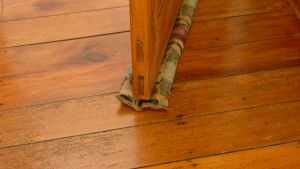Government stats show a third of New Zealand homes are too cold in winter. As part of a year-long survey, Stats NZ took temperature measurements in approximately 6700 homes. The top concern was that in around a third of homes, the recorded temperature in winter was under 18C, which is below the World Health Organisation’s minimum healthy indoor temperature.
For people living in homes where the recorded temperature was lower than 16C, 45% said they could see their breath inside during winter. If you’re piling on the layers, or you’re one of the Kiwis who admit to seeing their breath hanging in the air inside during winter, it’s time to ensure your home has proper insulation. We’ve compiled a few DIY tips below.

DIY 1: Add insulation to drafty windows
One easy, inexpensive, and practical way of sealing off windows for the winter is by using plastic sheeting and a hairdryer. It costs a fraction of the price of double glazing, yet offers great performance in reducing heat loss and condensation in your home. You can get DIY window insulation kits and low-emissivity window film from any hardware store, like Mitre 10. Just stick the sheeting to the walls and window sill and tighten the plastic by blowing hot air on it with a hairdryer.
If you are able to splurge, installing double glazing is well worth the money. Double-glazed windows are essentially two panes of glass with air or gas trapped in-between. They eliminate heat loss through windows, improving warmth and dryness in your home. Having them installed can also remove condensation build-up in cold weather. If you have to prioritise where your money goes in terms of installing double-glazed windows, target the heated areas of your home and large windows.
DIY 2: install curtains for insulation
Good quality blinds or curtains can go a long way to stopping heat loss through draughty windows. Thermally lined curtains can also prevent heat loss from windows in particularly cold areas. They can work as effectively as double glazing on your windows to retain heat and reduce your energy bills.
Lined and well-fitted roman blinds also keep heat in well. Know that it’s all about the seal you create between the curtain and window. If your curtains are too short, or sit too far from the window, the cold air will leak into the room. Make sure they are fitted properly. If you’re attempting a DIY approach and installing insulated curtains yourself, ideally you should:

- Fit them tightly against the window frame or wall
- Make sure they are slightly wider than the frame or wall
- Ensure they are full-length and hit the floor (if over a sliding door/floor-length window)
- Make sure they are double-layered
DIY 3: insulate your water heater
Put a jacket on your water heater and keep your water warmer during the winter without having to use excess energy to heat it. Just buy a fiberglass jacket from a hardware/DIY store and wrap it around your water heater like a blanket. This extra layer of insulation will reduce heat loss hugely, and save you money on your power bill.
DIY 4: seal your doorways
It’s worth putting foam weather-stripping around the inside of your door to create a seal and prevent air exchange. Draft stoppers are also a great DIY short-term solution for stopping drafts sneaking in under the bottom of the door. You can pretty easily make your own DIY window draft stoppers using rice and some fabric.

DIY 5: keep up to date with your HVAC maintenance
Do you have an HVAC system in your home? HVAC is a commonly used acronym meaning Heating, Ventilation, and Air Conditioning. It aims to provide thermal control and indoor comfort. It’s worth keeping up regular maintenance. This means changing your air filters when needed with a quality filter, cleaning your ducts regularly and repairing any leaks in your ducts. You don’t want heat escaping. The same regular maintenance goes for your heat pump.

Save money this winter with a better power plan
If heating your home and saving money is on your mind, the first step is to make sure you’re on a great power plan. You could save more than you think. A good place to start is Canstar’s most recent review of electricity providers, which you can find here, as it lists all the big players. And for more information, check out our story: Simple Guide to Finding the Cheapest Power Deals.
Canstar Blue’s latest review of NZ power companies compares them on customer satisfaction and value for money. The table below is an abridged version of our full results. Click on the big button at the bottom of the story for more details!
^ By clicking on a brand or 'details' button, you will leave Canstar Blue and be taken to either a product provider website or a Canstar Blue NZ brand page. You agree that Canstar Blue NZ’s terms and conditions apply (without limitation) to your use of this service,to any referral to a product provider from our website, and any transaction that follows. Canstar Blue may earn a fee for referrals from its website tables, and from sponsorship (advertising) of certain products. Payment of sponsorship fees does not influence the star rating that Canstar Blue awards to a sponsored product. Fees payable by product providers for referrals and sponsorship may vary between providers, website position, and revenue model. Sponsorship fees may be higher than referral fees. Sponsored products are clearly disclosed as such on website pages. They may appear in a number of areas of the website such as in comparison tables, on hub pages and in articles. Sponsored products may be displayed in a fixed position in a table, regardless of the product’s rating, price or other attributes. The table position of a sponsored product does not indicate any ranking, rating or endorsement by Canstar Blue. See How we are funded for further details.
Canstar Blue NZ Research finalised in April 2023, published in June 2023.
See Our Ratings Methodology
Enjoy reading this article?
You can like us on Facebook and get social, or sign up to receive more news like this straight to your inbox.
By subscribing you agree to the Canstar Privacy Policy


Share this article